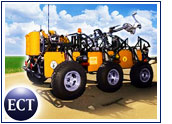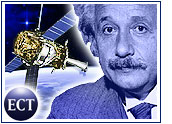
The early-morning sunshine that lit up the outskirts of Los Angeles on March 13, 2004, revealed a strange and wonderful collection of vehicles gathered in the dusty landscape. A variety of four-wheel-drive trucks and SUVs bristling with electronic gear contrasted with custom-built models resembling lunar rovers.
There were vehicles with two, four and even six wheels. They ranged in size from a motorcycle to a 32-ton truck, and in cost from US$35,000 to $3.5 million.
All were gathered that brisk morning to participate in the first DARPA Grand Challenge. DARPA, the U.S. Government’s Defense Advanced Research Projects Agency, known for its philosophy that no idea is too strange to consider, has a vision of future battlefields populated by autonomous robot vehicles, fighting and transporting goods without human intervention.
The civilian spin-offs from a successful robot-vehicle technology are immediately obvious, too.
DARPA’s Gauntlet
So DARPA threw down the gauntlet to American technology and innovation, offering a million-dollar prize to the team that could build an autonomous vehicle able to cross more than 225 miles of rough country between Los Angeles and Las Vegas — while avoiding environmentally sensitive areas — in just 10 hours. The vehicles, navigating by GPS, could not be controlled by humans in any way.
Some 100 technical approach submissions were evaluated by DARPA and whittled down to a field of 25 finalists. After qualifying trials, 15 vehicles fronted up at the starting line March 13th. But all the high hopes were dashed: The most successful entrant, “Sandstorm” from Carnegie-Mellon Institute’s “Red Team,” made it just 7.4 miles.
The others came to grief in a variety of ways: getting lost, tipping over, getting snagged on barbed wire, burning up their tires in an effort to extricate themselves from obstacles, or failing to start altogether.
Negotiating the Learning Curve
Disappointing as the results may have been, many teams are now analyzing their failures, planning and building for the 2005 Challenge. New teams are planning to enter as well. The incentive has gotten bigger, too: The prize has been doubled to $2 million. Many entrants seem to see the cash prize as merely a nice bonus: The real motivators are the technical challenge and the fun of the thing. Nevertheless, shortage of time and money were recurring themes among the racers, and many are actively seeking sponsors.
There are two main types of problem to be solved: the physical passage over a rough and varied landscape (at an average speed of at least 25 miles per hour) and the tasks of navigation and of sensing and avoiding obstacles.
Many teams concluded that a rugged truck or all-terrain vehicle would be able to handle the desert landscape: Only six of the original entrants were built from the ground up for the challenge.
The sensing and navigation systems approached their tasks from several angles. Solutions came in the form of Differential GPS, Doppler radar, Laser Imaging Detection and Ranging (LIDAR), ultrasonic touch-sensors, Forward Looking Infrared Radar (FLIR), stereoscopic video cameras, inertial sensing, axle encoding and, of course, onboard computing power — lots of it.
What stopped the robot racers? The reasons were as varied as the designs themselves, but, in general, navigation problems and obstacle avoidance ended more racers’ runs than mechanical problems did. TechNewsWorld asked several teams about their problems and how they are setting out to solve them.
Hindsight and Next Steps
According to William “Red” Whittaker, veteran robot-builder and team leader for the Carnegie-Mellon “Sandstorm” humvee, “Several small sources of navigation error summed up to a sufficient cross-track error to guide one of Sandstorm’s wheels over a berm…. Once the wheel crossed the berm and lost traction, the remaining wheels lost driving torque.” The navigation software has now been corrected.
Other improvements for next year include locking differentials to enable exceptional locomotion when called for. The Red Team also will field a second, more experimental challenger in the next race.
SciAutonicsII, one of whose two vehicles had run 6.7 miles when GPS signal interruptions stopped it, will have two machines next year, according to spokesperson Paul Gunthner, and will spend some $3.6 million on both. We can expect to see improvements in their 3D stereo vision systems, laser and pinhole cameras that should allow speeds up to 60 mph.
Team Caltech’s entry, named Bob, made it 1.3 miles before meeting its match in a barbed-wire fence. Team leader David van Gogh said the lack of a road-following algorithm led to Bob’s veering off the track and into the wire.
The 2005 entry, named Alice, probably will get that algorithm (and an improved speed control algorithm), but to be on the safe side, said van Gogh, “We will have some sort of contact sensor at the front, which will tell the vehicle if it’s hitting something like barbed wire.” Alice also may feature a gimbaled (motion-stabilized) sensor platform for its stereovision or LADARs.
Improving the Algorithms
Terra Engineering’s “Terrahawk” was forced to withdraw on the morning of the race due to a compressor failure. Team leader Todd Mendenhall felt that the team’s “built-from-scratch vehicle had more rough terrain capability than any other vehicle in the race,” but he added that the team’s “sensor suite and fusion techniques were average at best.” If Terra can find funding to enter the 2005 race, he said, “primary improvements will be in the algorithms.”
Such complex technical problems and diversified teams mean varied philosophies of system design and race tactics. Some were altruistic, as at Caltech — where, according to David van Gogh, “our philosophy is to create a learning opportunity for the Caltech undergrad students on the team. Winning is secondary.”
Some were gung-ho: “We have a lead foot in our camp,” said Paul Gunthner of SciAutonics.
Gary Carr from Team Ensco said he believes that “choosing when to go slow and when to go fast is the key to the race,” while Red Whittaker noted, “the Grand Challenge is a cerebral race that requires as much subtlety and planning about speed as it requires deliberation about route.”










































